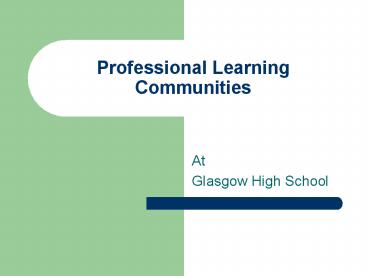Professional Learning Communities PowerPoint PPT Presentation
1 / 18
Title: Professional Learning Communities
1
Professional Learning Communities
- At
- Glasgow High School
2
What are Professional Learning Communities (PLCS)?
- A professional learning community is
characterized by the collaborative work of
educators to continuously seek, share, and act on
their learning in order to improve - their practice for the purpose of improved
student outcomes (Astuto, 1993).
3
Why Are Professional Learning Communities
Important?
- They function as an effective strategy for
building school capacity around core issues of
teaching and learning (Darling-Hammond, 1995) - They foster the democratic practices required to
undertake and sustain fundamental, systemic
change (Bryk, 1994) and, - They can serve as a mechanism for transforming
school culture.
4
How Do PLCS Impact Students?
- By modeling collegiality, intellectual inquiry,
critical discourse, and continuous improvement,
professional learning communities raise the
expectation and standard for students level of
engagement, development, and achievement. - Studies indicate that students tend to be engaged
in learning at high intellectual levels when the
adults are engaged with one another and with
their students at high intellectual levels around
a shared vision for student success.
5
What are Key Characteristics of PLCS?
- Shared Norms and Values
- (Vision/Mental Image)
- Collective Responsibility for Shared Norms and
Values - Focus on Student Learning
- De-Privatization of Practice
- Collaboration/Collective Creativity
6
Conditions and Structures Necessary to Support
PLCS
- School leadership support, school autonomy and
shared decision- making. - Time for teacher planning and analysis.
- Professional development opportunities.
- Resources.
- Training in the skills required to facilitate
collaborative work.
7
Quality PLCS are characterized bythe same
attributes associated with high quality
professional development.
- They shift the notion of professional competence
from individual teacher expertise to professional
community expertise - They foster a collective sense of responsibility
for students progress (Anderson, Rolheiser,
Gordon, 1998) - They are inherently job-embedded and team-based
(Darling-Hammond, 1996,1998b) - They require a community of learners to translate
into higher levels of learning for all (Jones,
1998 Sparks Hirsh, 1997) and, - They are embedded in school-wide goals for
student learning specific to the school community
(Renyi, 1998 CCSSO, 1997 Sparks,1998).
8
PLCS Use Defined Protocols.Some Examples
- ATLAS Learning from Student Work
- The Charette
- Collaborative Assessment Conference
- Consultory
- Critical Incident Protocol
- Descriptive Review of Student Work
- Tuning protocol.
9
PLCS Set SMART Goals
- Specific
- Measurable
- Attainable
- Realistic
- Tangible
10
PLCS Produce Real Products
- PLC logs
- PLC Action Plans
- PLC Portfolios
11
Observed Outcomes For Staff
- Increased commitment to the mission and goals of
the school and increased vigor in working to
strengthen the mission. - More satisfaction, higher morale, and lower rates
of absenteeism. - Significant advances in adapting teaching to the
students accomplished more quickly than in
traditional schools. - Commitment to making significant and lasting
changes. - Higher likelihood of undertaking fundamental
systemic change.
12
Observed Outcomes For Staff
- Shared responsibility for the total development
of students and collective responsibility for
students' success. - Reduction of isolation of teachers.
- Powerful learning that defines good teaching and
classroom practice and that creates new knowledge
and beliefs about teaching and learners. - Increased meaning and understanding of the
content that teachers teach and the roles they
play in helping all students achieve
expectations. - Higher likelihood that teachers will be well
informed, professionally renewed, and inspired to
inspire students.
13
Observed Outcomes for Students
- Decreased dropout rate and fewer classes
"skipped. - Lower rates of absenteeism.
- Increased learning that is distributed more
equitably in the smaller high schools. - Greater academic gains in math, science, history,
and reading than in traditional schools. - Smaller achievement gaps between students from
different backgrounds.
14
When Do PLC Teams Work Together?
- Common Plan Time
- During Inservice Time
- During Meeting Times
- After School
- During School (release time)
15
What is the Timeline for Implementation for PLCS
at GHS?
- Aug. 25 -PLC Teams Established, Initial meeting
and Task Completed. - September Defined/discrete tasks completed
(Including team building and training in
collaborative interactions). - October- Development/Approval for Action Plan for
PLC Team Project. Work on Project. - November-Completion of Project, Team Portfolio,
Self/Team PLC Evaluation. Sharing of Results.
Revision of teams as necessary. - December-New/revised Action Plans. Work on
Project. - January- Work on Project. Portfolio Update.
16
Examples of PLC Projects
- Lesson Study
- Differentiating Instruction
- Developing Interdisciplinary Units
- Integrating Community Resources
- Using MAP Data to Drive Instruction
- Incorporating Instructional Technology
- Using Formative Assessments
17
All PLC Work Has in Common
- Focus on Student Learning.
- Analysis of Student Work/Performance.
- Collaboration/Collective Creativity.
- Teacher Reflection on Practice.
18
Together We CAN Make a Difference!

